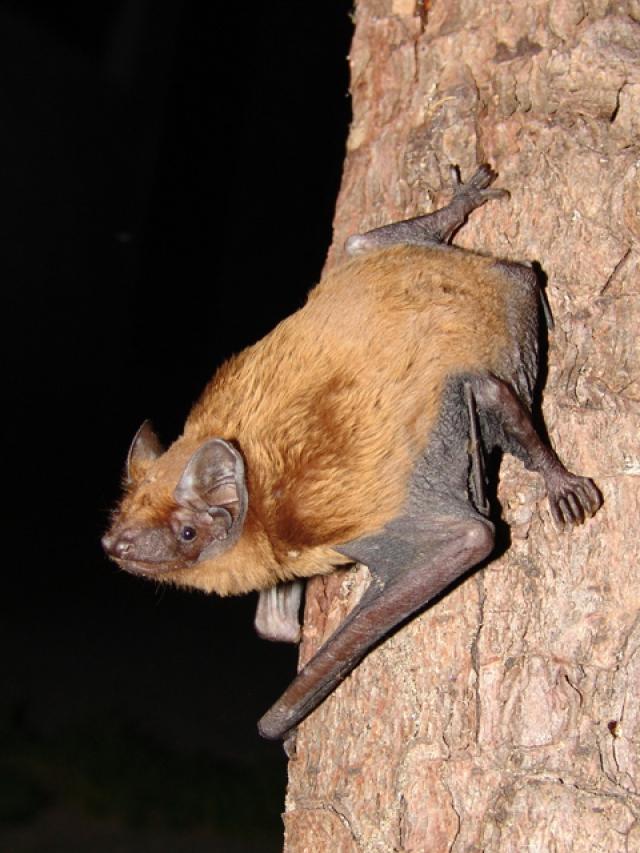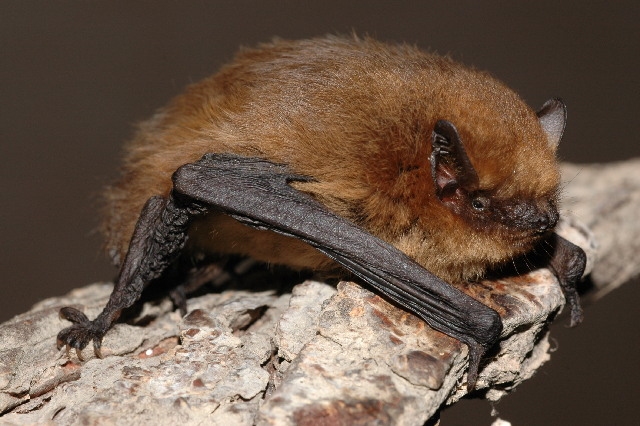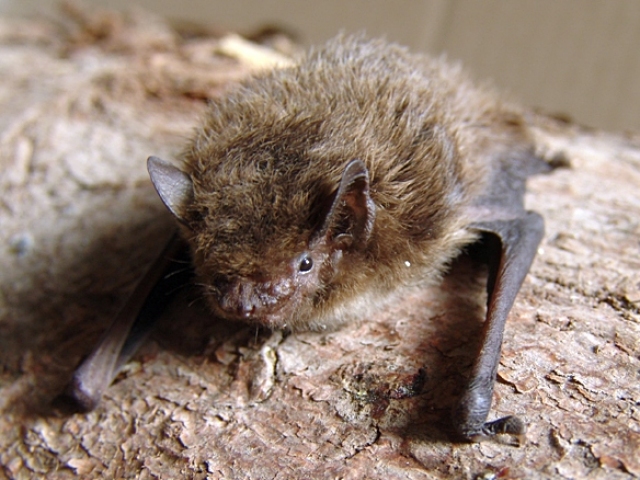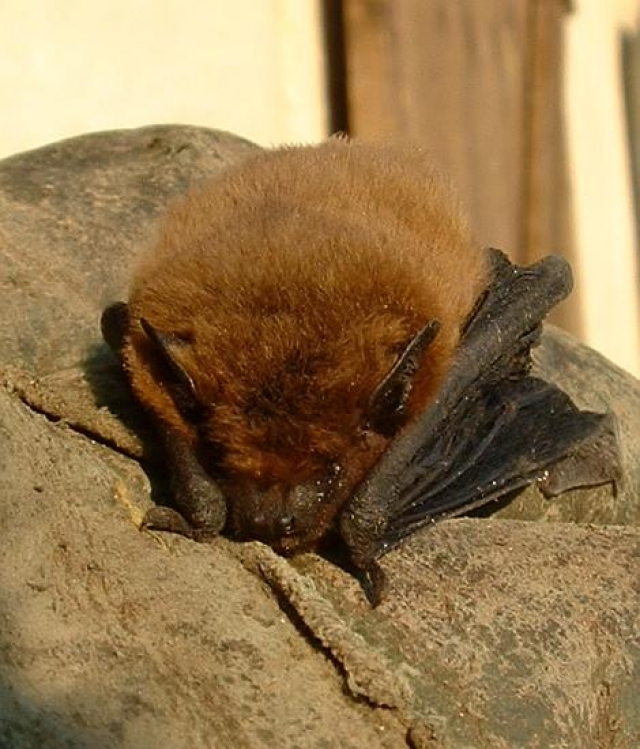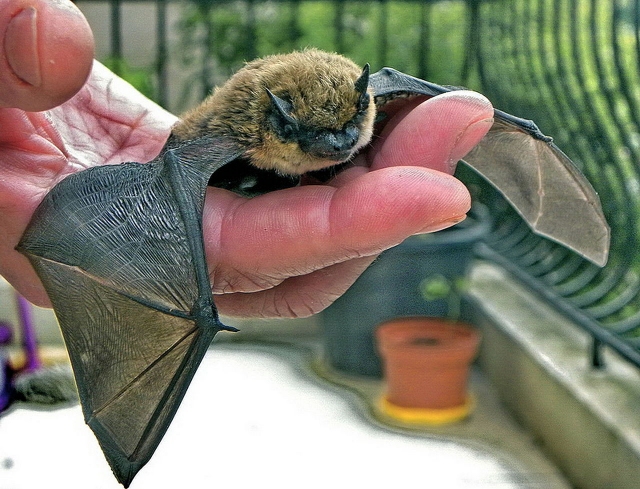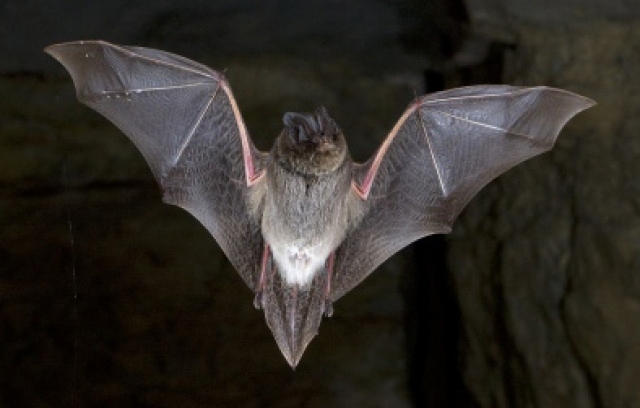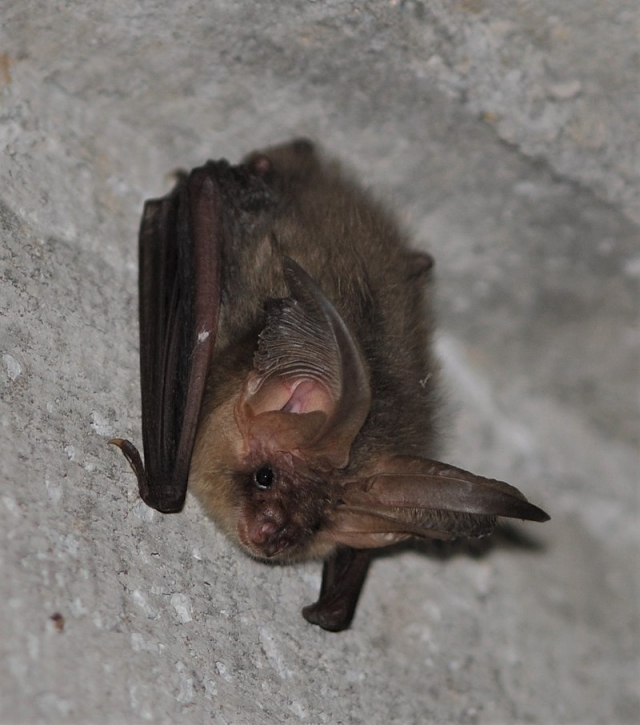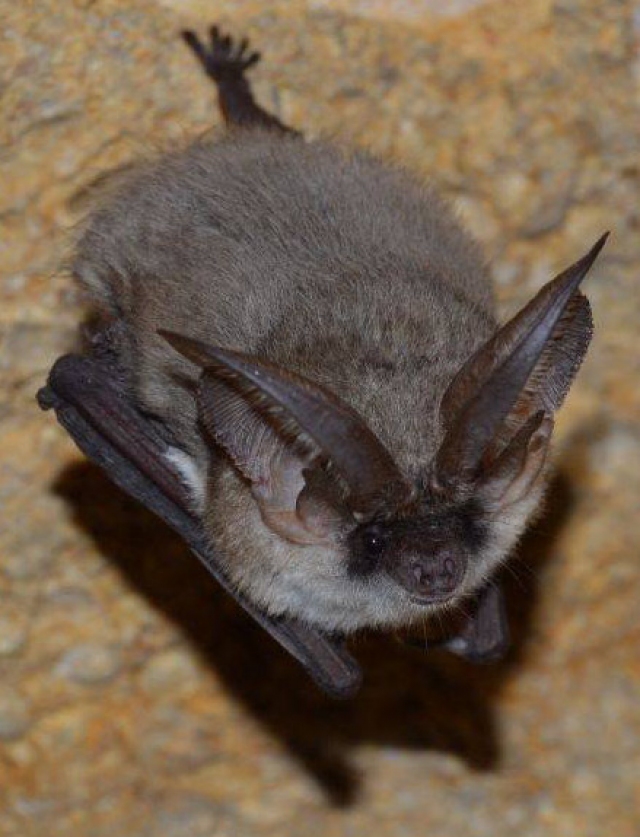Florian Heigl
Leather-winged bat
Description
Its chirping calls, which remind us of birds, can be heard especially in autumn during the mating season. It has a maximum body size of 6.4 cm with a wingspan of 27 to 33 cm and a weight of 12 to 23 g. It got its name from its short-haired, two-coloured back fur. It got its name from its short-haired, dense bicoloured dorsal fur. It is reddish to dark brown and silvery white at the tips of the fur. The belly is also white to greyish. The ears, wings and face are blackish brown. Their wings are narrow in relation to the body and the last caudal vertebra protrudes freely from the uropatagium. The ears are short, broad and roundish.
A characteristic of the leather-winged bat is the presence of four teats in the female. No other European species has this feature.
Habitat
The leather-winged bat prefers four types of landscape, namely wooded mountains, steppes and farmland, the shore regions of lakes and, in Europe, especially the vicinity of cities.
The text is a translation of an excerpt from Wikipedia (https://de.wikipedia.org/wiki/Zweifarbfledermaus). On wikipedia the text is available under a „Creative Commons Attribution/Share Alike“ licence. Status: 09 August 2021
Common noctule
Description
The short coat is close-fitting and shiny rusty brown over the entire body. With a maximum body length of 8.2 cm and a wingspan of 40 cm, it is between the size of its two relatives on the European continent. Very noticeable are the distinct glandular bulges in the corners of the mouth, which can be seen when the mouth is open.
Habitat
As a typical tree bat, it inhabits old (woodpecker) cavities in trees in small groups, sometimes in larger groupings; however, it also uses buildings and sometimes nest boxes as roosts.
The text is a translation of an excerpt from Wikipedia (https://de.wikipedia.org/wiki/Großer_Abendsegler). On wikipedia the text is available under a „Creative Commons Attribution/Share Alike“ licence. Status: 09 August 2021
Soprano pipistrelle
Description
The soprano pipistrelle is a sibling of the common pipistrelle.
It differs from the common pipistrelle in that it is slightly smaller and thus represents the smallest Central European bat species. Also, its echolocation sounds are not at the usual 45 kHz, but have a final frequency of about 55 kHz.
The text is a translation of an excerpt from Wikipedia (https://de.wikipedia.org/wiki/Mückenfledermaus). On wikipedia the text is available under a „Creative Commons Attribution/Share Alike“ licence. Status: 13 August 2021
Nathusius's pipistrelle
Description
It achieves a maximum body size of around 5 to 6 cm and a wingspan of up to 25 cm with a weight of 6 to 10 g. Its appearance makes it easy to confuse with the other pipistrelle bats. A good distinguishing feature from the common pipistrelle and soprano pipistrelle is the 5th finger, which is usually longer in the Nathusius's pipistrelle.
Habitat
The Nathusius's pipistrelle summer habitats are crevice roosts such as trunk cracks, tree hollows and rock crevices, but they can also be found on buildings, e.g. behind wooden panelling. In winter, the species often occupies wood piles or tree hollows.
The text is a translation of an excerpt from Wikipedia (https://de.wikipedia.org/wiki/Rauhautfledermaus). On wikipedia the text is available under a „Creative Commons Attribution/Share Alike“ licence. Status: 13 August 2021
Kuhl's pipistrelle
Description
With a size of up to 4.7 cm, it is only slightly larger than its sister species, the common pipistrelle. Its wingspan is around 22 cm and it weighs 5-10 grams.
When the wings are open, it is easy to see that there is a 1-2 mm wide, light-coloured fringe between the last phalanx and the foot on both sides, which gave the Kuhl's pipistrelle its name.
Habitat
It inhabits forests and grasslands of temperate climates, but also rural gardens and urban areas.
The text is a translation of an excerpt from Wikipedia (https://de.wikipedia.org/wiki/Weißrandfledermaus). On wikipedia the text is available under a „Creative Commons Attribution/Share Alike“ licence. Status: 13 August 2021
Common pipistrelle
Description
The common pipistrelle is the most widespread bat species in Europe. It is one of the smallest representatives of the mammals with a wingspan of up to 25 cm. Along with the soprano pipistrelle bat, it is one of the smallest within its genus.
It reaches a body size of 4.5 cm and a wingspan of up to 25 cm with a weight of 3.5 to 7 g. It thus weights only a little more than sugar cube and is the size of a matchbox when its wings are folded. Its fur colouration is reddish brown to dark brown, the underpart yellowish brown to greyish brown.
Habitat
Common pipistrelle bats prefer to hunt along vegetation structures. Their main food is insects, especially dipterous insect such as chiggers. Preferred hunting habitats are flown over and hunted for a longer period of time. Unlike other light-shy bat species, common pipistrelle bats also hunt in urban areas around street lighting.
The text is a translation of an excerpt from Wikipedia (https://de.wikipedia.org/wiki/Zwergfledermaus). On wikipedia the text is available under a „Creative Commons Attribution/Share Alike“ licence. Status: 13 August 2021
Savi's pipistrelle
Description
The Savi's pipistrelle achieves a snout-vent length of 4.0 to 5.4 cm with a tail length of 3.1 to 4.3 cm and a wingspan of 22 cm. Its weight is 5 to 10 g. This makes it one of the smaller bat species in Europe. Its fur is relatively long and yellowish to dark brown on the upperparts with a black-brown hair base and shiny hair tips. The underparts are whitish-yellow to greyish-white, clearly distinguishing them from the upperparts. The ears and snout are almost black, the wings dark brown. The young, which are able to fly, are somewhat darker than the adults and still have hardly any or no light fur tips.
Compared to the European pipistrelles (Pipistrellus), the ears are broader and rounder, they have four ear folds. The ear length is 10 to 15 mm. The tragus is short and widens slightly towards the top, it has two opposing teeth at the base and the rounded tip is turned inwards. The forearm has a length of 30.0 to 36.5 mm. The arm patagium attaches to the toe root. The last two caudal vertebrae are free at 3 to 5 mm in length.
Habitat
Foraging usually takes place at higher altitudes over open woodland and over pasture and wetland areas. However, they also live in inhabited areas and, especially in southern Europe, in cities, where they catch insects around lighting systems, among other places. They also hunt near rock faces or above treetops.
They find their roosts and resting places in rock crevices, but also in cracks in buildings or under tree bark. Very rarely they are found in underground habitats and caves.
The text is a translation of an excerpt from Wikipedia (https://de.wikipedia.org/wiki/Alpenfledermaus). On wikipedia the text is available under a „Creative Commons Attribution/Share Alike“ licence. Status: 13 August 2021
Barbastelle
Description
The size is between 4.5 and 5.8 cm with a wingspan of 26 to 29 cm and a weight of 6 to 13 g. It got its name from the pug-like snout. Their fur and flight skins are almost black, the ventral side dark grey. Barbastelle bats also have white tips on their backs, giving them a frosted appearance. The ears are broad (trapezoidal) and fused at the base.
Habitat
The roosts of the barbastelle bat are usually in forests. In particular, hiding places behind bark and in cracks in the trunk are used. Tree hollows, on the other hand, are of lesser importance. The bat species most frequently uses roosts in old and deadwood-rich oak and beech forests. Habitat trees in young oak forests are also frequently used. The stands, which are at the end of the differentiation phase, usually have large amounts of weak, standing deadwood. In addition to natural habitats, anthropogenic roosting opportunities such as bat flat boxes or window shutters are also accepted.
The text is a translation of an excerpt from Wikipedia (https://de.wikipedia.org/wiki/Mopsfledermaus). On wikipedia the text is available under a „Creative Commons Attribution/Share Alike“ licence. Status: 17 August 2021
Brown long-eared bat
Description
The fur of the brown long-eared bat is long and loose and has a grey-brown colour, the underpart and the neck are clearly lighter grey and bear a yellowish spot. The most striking feature are the ears, which at about 4 cm long are almost as long as the body. The front edge of the ears is heavily ciliated. The ears are upright at the beginning of the flight and remain upright during the flight itself. During daytime lethargy (torpor) and hibernation they are folded back under the wings. Especially in winter, the snout is significantly enlarged due to the glands on the nose. Brown long-eared bats reach a body length of around 42 to 53 mm, a wingspan of 24 to 29 cm and a weight of 5 to 11 g.
Habitat
Brown long-eared bats are forest dwellers to a greater extent than other long-eared species. They prefer loose deciduous and coniferous woodland or parkland, often flying in dense undergrowth, their broad wings helping with manoeuvrability. They are also capable of shaking flight, in which the position remains unchanged in relation to an earth-fixed point. They use trees as roosts, sometimes bird or bat boxes or buildings. For winter habitats during hibernation, they use caves or mines.
The text is a translation of an excerpt from Wikipedia (https://de.wikipedia.org/wiki/Braunes_Langohr). On wikipedia the text is available under a „Creative Commons Attribution/Share Alike“ licence. Status: 17 August 2021
Gray long-eared bat
Description
The gray long-eared bat reaches an average snout-vent length of 41 to 58 mm, maximum lengths of up to 60 mm can occur. The tail is 37 to 55, maximum 57 mm long, and the wingspan is 255 to 292 mm. Like other long-eared bats, the particularly pronounced ears stand out, reaching lengths of 31 to 41 mm and showing about 22 to 24 transverse folds. The body weight is 5 to 13 g.
In appearance and size, the gray long-eared bat resembles the brown long-eared bat (Plecotus auritus), but the colour of the relatively long coat is slate-grey at the base of the hair, so that the upperparts are rather grey and only rarely show a slight brownish tinge. The underparts are also grey. The grey mask around the relatively large eyes is striking, and the animal's snout is also slightly longer and more pointed. Other differences are found in less conspicuous features such as the shorter toe fur, the thickened end of the penis and the length of the penis.
As in the brown long-eared bat, the wings are relatively broad and the arm patagium attaches to the base of the toes.
Habitat
During the summer, bats stay in their summer habitats or nursery roosts, which are usually located in buildings. They are mainly found in roofs, where they sometimes live freely in the roof ridge or crevices or spaces between beams. The roosts are sometimes also inhabited by other species, such as the greater mouse-eared bat (Myotis myotis) or the lesser horseshoe bat (Rhinolophus hipposideros). Individuals are also found in caves and rarely in bat boxes. Summer habitats serve as a starting point for hunting and as a resting place during the day.
The gray long-eared bat hunts during the night. The departure from the summer habitat takes place with the onset of darkness. Prey is caught mainly in the open air, and long-eared bats are considered to be skilful flyers with fluttering flight. They fly at speeds of 10 to 30 km/h and at heights of between 0.5 and 10 m. They also collect prey from the ground. In addition, they also collect prey from leaves, which they can detect with the ultrasonic system.
The text is a translation of an excerpt from Wikipedia (https://de.wikipedia.org/wiki/Graues_Langohr). On wikipedia the text is available under a „Creative Commons Attribution/Share Alike“ licence. Status: 17 August 2021


